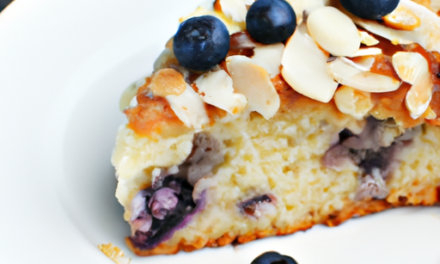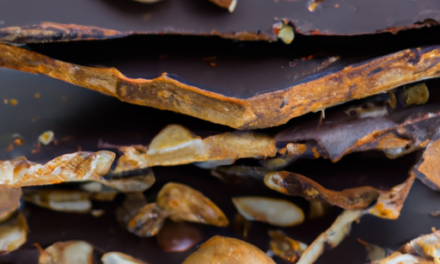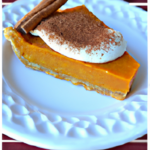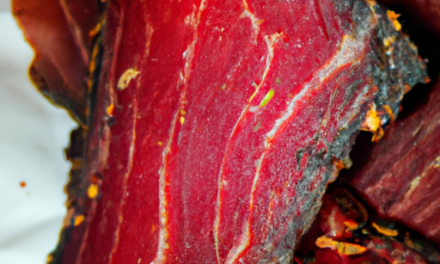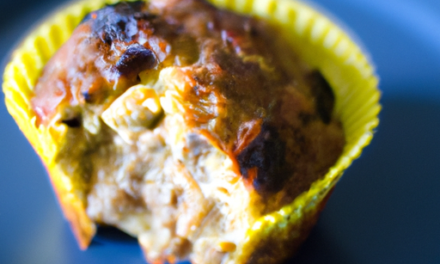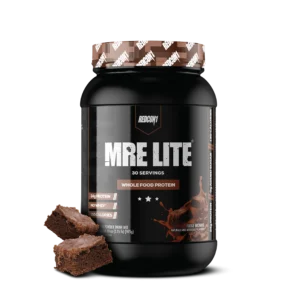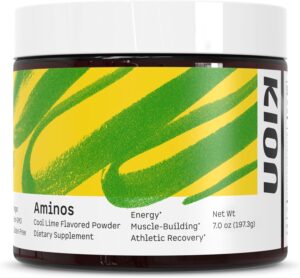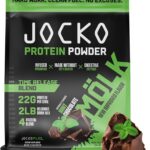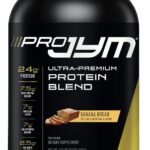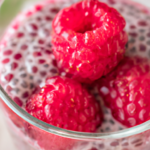
Spaghetti Squash With Pesto And Cherry Tomatoes
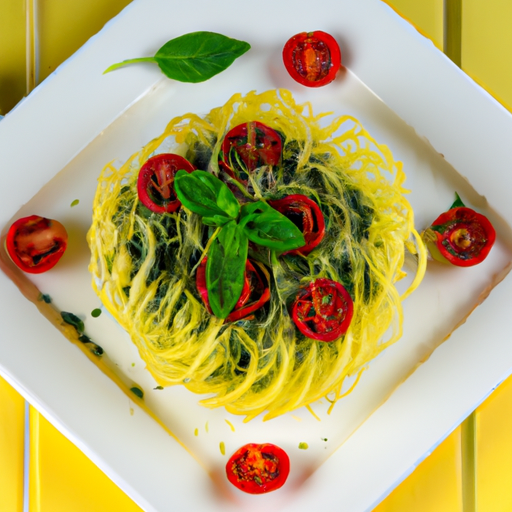
Imagine diving into a plateful of tender spaghetti squash strands, coated in a vibrant pesto sauce and topped with sweet cherry tomatoes. It’s a dish that not only satisfies your taste buds but also supports your health goals. As a part of Paleo Friendly Recipes, this medley of flavors is a delightful way to enjoy a nutritious meal while staying on track with your wellness journey. With every bite, you’ll savor the freshness of the tomatoes and the aromatic blend of herbs in the pesto, making this Spaghetti Squash with Pesto and Cherry Tomatoes a must-try recipe.
Ingredients
Spaghetti Squash
Spaghetti squash is a healthy and delicious alternative to traditional pasta. It gets its name from the long, thin strands it forms when cooked, resembling spaghetti noodles. This versatile vegetable is packed with nutrients and is low in calories and carbohydrates, making it a great option for those following a Paleo or low-carb diet.
Pesto
Pesto is a flavorful sauce made from fresh basil, garlic, pine nuts, olive oil, and Parmesan cheese. It adds a burst of herbaceous and savory taste to any dish. While you can make your own pesto from scratch, you can also use store-bought pesto if you’re short on time or ingredients.
Cherry Tomatoes
Cherry tomatoes are small, bite-sized tomatoes that are perfect for adding a pop of color and sweetness to any dish. They are rich in antioxidants, such as lycopene, which has been linked to numerous health benefits, including reducing the risk of heart disease.
Olive Oil
Olive oil is an essential ingredient in this recipe, as it helps to enhance the flavors of the other ingredients and adds a smooth and silky texture to the dish. It is also rich in healthy fats, which are beneficial for heart health and can help to reduce inflammation in the body.
Salt
Salt is used to season the dish and enhance the flavors of the other ingredients. Be sure to use a good quality sea salt or kosher salt for the best results.
Black Pepper
Black pepper adds a mild, slightly spicy flavor to the dish. It pairs well with the other ingredients and helps to balance out the flavors.
Garlic
Garlic is a staple ingredient in many savory dishes as it adds a delicious, aromatic flavor. It is also known for its health benefits, including boosting the immune system and reducing the risk of certain chronic diseases.
Parmesan Cheese
Parmesan cheese adds a rich and nutty flavor to the dish. It is used both in the pesto sauce and as a garnish. If you’re following a dairy-free or vegan diet, you can substitute Parmesan cheese with a dairy-free alternative or omit it altogether.
Preparation
Cooking the Spaghetti Squash
To cook the spaghetti squash, start by preheating your oven to 400°F (200°C). Cut the squash in half lengthwise and scoop out the seeds and pulp. Drizzle the cut sides with olive oil and sprinkle with salt and black pepper. Place the squash halves cut side down on a baking sheet and roast in the oven for 40-50 minutes, or until the flesh is soft and easily pierces with a fork. Once cooked, use a fork to scrape the flesh into strands, resembling spaghetti noodles.
Making the Pesto
If you’re making your own pesto, combine fresh basil, garlic cloves, pine nuts, Parmesan cheese, and a pinch of salt in a food processor or blender. Pulse until the ingredients are finely chopped. With the machine running, slowly drizzle in olive oil until the pesto reaches your desired consistency. Taste and adjust the seasoning if needed. If you’re using store-bought pesto, simply give it a good stir to ensure it is well mixed.
Preparing the Cherry Tomatoes
Rinse and dry the cherry tomatoes. For added flavor, you can slice them in half or leave them whole, depending on your preference. If you prefer a roasted flavor, you can also toss the cherry tomatoes with a little olive oil, salt, and black pepper and roast them in the oven at 375°F (190°C) for about 10-15 minutes, or until they are slightly softened and caramelized.
Instructions
Step 1: Cook the Spaghetti Squash
Preheat your oven to 400°F (200°C). Cut the spaghetti squash in half lengthwise and remove the seeds and pulp. Drizzle the cut sides with olive oil and sprinkle with salt and black pepper. Place the squash halves cut side down on a baking sheet and roast for 40-50 minutes, or until the flesh is tender. Use a fork to scrape the flesh into strands.
Step 2: Make the Pesto
If making your own pesto, combine fresh basil, garlic cloves, pine nuts, Parmesan cheese, and a pinch of salt in a food processor or blender. Pulse until finely chopped. Slowly drizzle in olive oil while the machine is running until the pesto reaches your desired consistency. Adjust the seasoning if needed. If using store-bought pesto, give it a good stir to ensure it is well mixed.
Step 3: Prepare the Cherry Tomatoes
Rinse and dry the cherry tomatoes. Slice them in half or leave them whole, depending on your preference. Alternatively, you can roast them by tossing them with olive oil, salt, and black pepper and baking them in the oven at 375°F (190°C) for 10-15 minutes until slightly softened and caramelized.
Step 4: Combine the Squash, Pesto, and Tomatoes
In a large mixing bowl, combine the cooked spaghetti squash, pesto sauce, and cherry tomatoes. Toss gently until everything is well coated and evenly distributed.
Step 5: Serve and Enjoy
Transfer the spaghetti squash mixture to a serving dish and garnish with grated Parmesan cheese. Serve warm and enjoy!
FAQs
What is spaghetti squash?
Spaghetti squash is a winter squash variety that, when cooked, forms long, thin strands that resemble spaghetti noodles. It is a low-calorie and nutrient-dense vegetable that can be used as a healthy alternative to traditional pasta.
How do I know when the squash is cooked?
You will know the spaghetti squash is cooked when the flesh is tender and easily pierced with a fork. The strands should come away easily from the skin and have a slightly al dente texture.
Can I use store-bought pesto?
Yes, store-bought pesto can be used as a convenient alternative to homemade pesto. Just be sure to give it a good stir to ensure it is well mixed before using it in the recipe.
Can I add other vegetables to the dish?
Absolutely! This recipe is versatile, and you can add other vegetables such as sautéed mushrooms, roasted bell peppers, or caramelized onions to add extra flavor and texture to the dish. You can get creative and customize it to suit your personal preferences.
Can I make this recipe vegan?
Yes, you can make this recipe vegan by using a dairy-free alternative to Parmesan cheese or omitting the cheese altogether. You can also make a vegan pesto by substituting nutritional yeast for the Parmesan cheese and omitting any animal-based ingredients.
Tips and Variations
Roasting the squash for added flavor
For an extra depth of flavor, you can roast the spaghetti squash cut side up in the oven. Drizzle it with olive oil, salt, and black pepper, and roast it at 425°F (220°C) for about 30-40 minutes, or until the edges are golden brown. This will enhance the natural sweetness of the squash and add a caramelized, roasted flavor to the dish.
Adding protein such as grilled chicken or shrimp
If you want to incorporate more protein into your meal, you can add grilled chicken breast or shrimp to the spaghetti squash dish. Simply cook the protein separately and add it to the dish when combining the squash, pesto, and tomatoes. This will make it a well-rounded and satisfying meal.
Using different types of pesto
While traditional pesto is made with fresh basil, you can experiment with different types of pesto to add variety to the dish. Try using arugula, kale, or spinach as the base instead of basil. Each variation will bring its own unique flavor profile and nutritional benefits.
Adding fresh herbs for extra freshness
To add a burst of freshness to the dish, consider adding some additional fresh herbs such as chopped parsley, mint, or cilantro. The bright flavors of the herbs will complement the other ingredients and elevate the overall taste of the dish.
Trying different types of cheese
If you’re not a fan of Parmesan cheese or prefer a different cheese variety, feel free to experiment with different types of cheese. You can try using Asiago, Pecorino Romano, or even a crumbled feta cheese for a tangy twist.
Health Benefits
Low in calories and carbohydrates
Spaghetti squash is an excellent choice for those looking to reduce their calorie and carbohydrate intake. It is significantly lower in calories and carbohydrates compared to traditional wheat-based pasta, making it a suitable option for weight management and blood sugar control.
High in fiber and nutrients
Spaghetti squash is rich in dietary fiber, which is essential for digestive health and maintaining a healthy weight. It is also a good source of vitamins A and C, potassium, and other important nutrients that support overall health and wellbeing.
Rich in antioxidants from tomatoes and olive oil
Cherry tomatoes and olive oil are both excellent sources of antioxidants. Antioxidants help to protect the body against damage from harmful free radicals and may reduce the risk of chronic diseases, such as heart disease and certain types of cancer.
Good source of healthy fats from pesto and olive oil
The pesto sauce and olive oil in this recipe contribute healthy fats, which are essential for a balanced diet. These fats, especially monounsaturated fats found in olive oil, have been associated with heart health and may help to lower bad cholesterol levels.
Naturally gluten-free and grain-free
Spaghetti squash is naturally gluten-free and grain-free, making it a suitable option for those with gluten intolerance or following a gluten-free diet. It can be an excellent substitute for pasta in various recipes.
Conclusion
Spaghetti Squash with Pesto and Cherry Tomatoes is a delicious and healthy option for a satisfying meal. It combines the natural sweetness of the spaghetti squash with the vibrant flavors of the pesto and cherry tomatoes. This recipe is versatile and can be customized to suit your personal preferences, whether you add extra vegetables, protein, or experiment with different types of cheese. It is particularly well-suited for those following a Paleo or low-carb diet, as it is low in calories and carbohydrates while being high in fiber and nutrients. Enjoy the benefits of this nutrient-packed dish and indulge in a guilt-free and flavorful meal.




